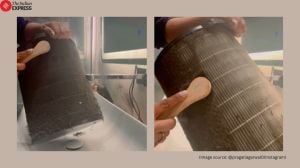In a big push to infrastructure spending, the Union government Friday approved eight national high-speed corridor projects under which 936-km length highways will be constructed at a cost Rs 50,655 crore.
After a meeting of the Prime Minister-chaired Cabinet Committee on Economic Affairs (CCEA), a statement by the government said the implementation of these projects will generate 4.42 crore mandays of direct and indirect employment.

Four of these eight highways will be executed under the Build-Operate-Transfer (BOT) model, indicating the government’s keenness to return to PPP (Public Private Partnership) projects. In the last financial year, only one of the total 176 projects was tendered under the BOT model.
Story continues below this ad
Under the BOT model, the private player owns up the investment risk, builds the projects fully on its own and maintains it for a specified period. It recovers the costs by collecting toll during this period, also called the concession period.
 (Photo: X/@narendramodi)
(Photo: X/@narendramodi)
The Ministry of Road Transport and Highways had on March 15, 2024, amended the Model Concession Agreement for Capacity Augmentation on BOT or toll projects, and made it more attractive to private players by introducing more liberal compensation, extension of concession period, and termination payments.
ExplainedPPP back on track
HAVING liberalised the model concession agreement, the government hopes the eight projects will make the private sector assume some financial risk and return to build highways under PPP mode. Such projects also create both direct and indirect employment.
It also brought in a new concept called ‘construction support’, under which NHAI would pay upto 40 per cent of the total project cost to the company building the highway in 10 instalments linked to physical progress in construction. Earlier, NHAI would provide only equity support to the company.
The four projects under the BOT model are: i) Rs 4,613 crore, 88-km six-lane Agra-Gwalior fully access-controlled high-speed corridor ii) the Rs 10,534 crore 214-km, six-lane Tharad-Deesa-Mehsana-Ahmedabad corridor iii) the Rs 5,729 crore, 121-km, four-lane Guwahati Ring Road, and iv) the Rs 7,827 crore, 30-km eight-lane, Nashik Phata-Khed corridor.
Story continues below this ad
 (Photo: X/@narendramodi)
(Photo: X/@narendramodi)
Of the remaining four highways, three are Hybrid Annuity Model (HAM) projects, and one will be executed under the EPC (Engineering, Procurement and Construction) mode. Under the EPC model, the company building the road does not carry any financial risk and the government pays it for laying the roads. But the government owns the road, maintains it, and is also the toll collector. HAM is a blend of the EPC and BOT model, where the private player is able to limit its risk. NHAI pays upto 40 per cent of the project cost, and the balance is raised by the private player. Here, the private company maintains the road for the duration of the concession period, but the government collects the toll.
The three projects under HAM are: i) the Rs 10,247 crore, 231-km four-lane Kharagpur-Moregram corridor ii) theRs 3,935 crore, 68-km, four-lane Ayodhya Ring Road, and iii) the Rs 4,473 crore, 137-km, four-lane Pathalgaon-Gumla section of Raipur-Ranchi corridor. The lone EPC project is the Rs 3,298 crore, 47-km six lane, Kanpur Ring Road.
 (Photo: X/@narendramodi)
(Photo: X/@narendramodi)
According to the government statement, the Agra-Gwalior corridor will reduce the distance by 7 per cent, by halve the travel time. The Kharagpur-Moregram highway will reduce the travel time for freight from 9-10 hours to 3-5 hours and help the economy of West Bengal and North East. Similarly, the Tharad-Ahmedabad highway will improve logistics efficiency by about 60 per cent, the government said.



 (Photo: X/@narendramodi)
(Photo: X/@narendramodi) (Photo: X/@narendramodi)
(Photo: X/@narendramodi) (Photo: X/@narendramodi)
(Photo: X/@narendramodi)





